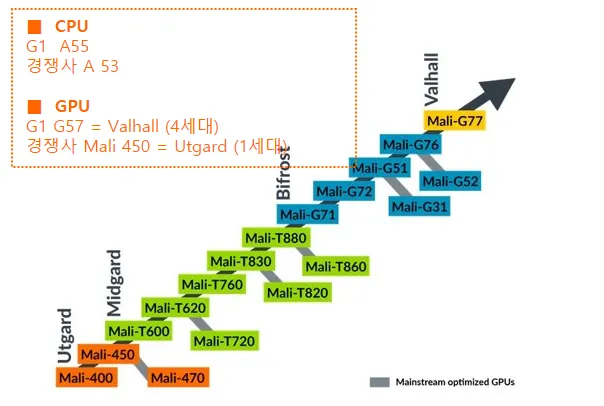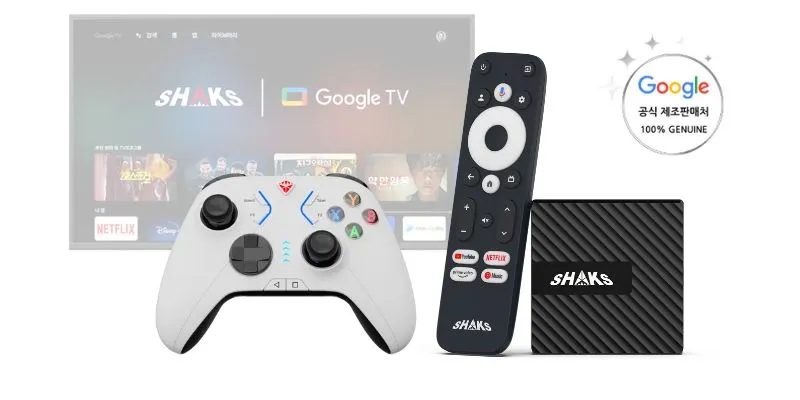Google TV is a significant advancement in the world of modern entertainment.  In this document, we will cover the technical performance and differences of the Sharks G1, which has gone through the verification process of Google TV.
In this document, we will cover the technical performance and differences of the Sharks G1, which has gone through the verification process of Google TV.
•
Platform differences
◦
‘23. As of November, the most widely used set-top box is the Amlogic S905 Y4 Platform, with DMIPS of 16.5K, but G1's is 20K. It is difficult to feel a difference in DMIPS 20K <-> 16.5K in general video services, but there is a difference in perceived response speed depending on the app that requires high-speed processing.
◦
Many products currently on the market use Mali G31 as their GPU, and the Sharks G1 is G57. Mali G31 and G57 are 32-bit GPUs designed by ARM. Both GPUs have 4 cores, but there are differences in clock speed and performance. Mali G31's clock speed is up to 700MHz. On the other hand, Mali G57's clock speed is up to 1.0GHz. The higher the Clock speed, the faster the GPU operates. So what we can understand is that Mali G57 runs about 43% faster than Mali G31.
◦
When using, differences between the above two may be observed as follows.
▪
Video playback: Mali G57 can provide smoother and clearer video playback than Mali G31. The difference is especially noticeable when playing high resolution or high frame rate videos.
▪
Gaming: Mali G57 can deliver smoother and more responsive gameplay than Mali G31. The difference is especially noticeable when playing games with complex graphics.
▪
Typical use: Mali G57 can provide faster app launch and boot time than Mali G31.
•
Experienced performance with 4K HDR support
◦
Increased resolution: 4K resolution is approximately 3840x2160 pixels, which is approximately 4 times more pixels than standard Full HD (1920x1080 pixels) resolution. This means the video is much clearer and has greater detail.
◦
HDR (High Dynamic Range): HDR expands the range of colors and contrast. This produces brighter whites and darker blacks, providing more vivid and realistic colors and allowing for finer details.
◦
Increased color rendition: With HDR, colors are more accurate and varied. This significantly improves realism, especially for nature shots and high-definition graphics.
◦
Improved contrast ratio: HDR provides a higher contrast ratio, better preserving detail between light and dark areas of the image. This is an important factor in improving overall image quality.
◦
A feature that automatically adjusts rendering quality according to the original video content is supported. This is supported starting from Google TV version 12 and is called “Adaptive streaming”.
▪
Adaptive streaming: is a function that automatically selects the optimal rendering quality suited to the device's performance and network environment by analyzing the resolution, frame rate, and bitrate of the original video content. This allows you to watch while maintaining the quality of the original content as much as possible, even if the device performance is low or the network environment is poor.
▪
Adaptive streaming: is enabled by default on Google TV. If you want to turn off this feature, you can set it as follows:
1.
Select the Settings icon on Google TV's home screen.
2.
On the Settings screen, select “System”.
3.
On the “System” screen, select “Adaptive streaming”.
4.
"Adaptive streaming"Set the switch to OFF.
•
Supports 4k Video output QMS, VRR, FRL of HDMI 2.1
◦
Quick Media Switching (QMS)
Quick Media Switching (QMS) is a feature of HDMI 2.1 that allows seamless switching between different refresh rates for content of the same resolution. This means the TV can instantly adjust its refresh rate to match that of the input content, with no visible defects or tearing. This is especially useful for eliminating stuttering and tearing that can occur when switching between games that use different frame rates.
◦
Variable Refresh Rate (VRR) Variable Refresh Rate (VRR) is a feature in HDMI 2.1 that allows the TV to dynamically adjust its refresh rate to match the frame rate of the input content. This means the TV can display content immediately without waiting for the next frame to be ready. This can help reduce input lag and make your gaming experience smoother and more responsive.
◦
Fixed Ratio Link (FRL)
Fixed Rate Link (FRL)is the signaling method used by HDMI 2.1 to transmit data between a source device and a TV. FRL uses 16b/18b encoding. This means that each data packet contains 16 bits of data and 18 bits of overhead. This overhead is used to ensure that data packets are transmitted reliably. FRL supports up to four fixed rate lanes. Each lane can transmit data at up to 12.154 Gbps. This means that FRL can support total data rates of up to 48.616 Gbps.
•
Dolby Atmus Support
◦
Among 4K HDR-supporting products, only a few products support Dolby Vision. Up to G1 Dolby Vision has been certified, so you can fully enjoy Netflix's Dolby Vision + Dolby Atmos.
◦
The TV must support Vision + Atmos, and support Dolby Atmos through. If your TV has built-in Atmos speakers, Atmos will be output. It must support Dolby MS12 to support Atmos pass through, and the G1 Dolby MS12 Audio certification has been completed.
•
Equipped with 16GB of flash memory, twice the size of competitors’ 8GB
◦
More storage space: 16GB provides twice the storage space of 8GB. This means users can store more applications, games, media files, and more on their devices.
◦
Increased application and content variety: Larger storage space allows users to install and use a variety of applications and content. This is especially useful if you use games or large apps.
◦
Improved performance: More storage space allows your system to run more efficiently. It can reduce performance degradation or delays that may occur when storage space is insufficient..
◦
Future-proof: Considering the trend of apps and games growing in size, larger memory capacity can provide users with a better experience in the long run.
◦
Easier to update and manage content: By having more storage space, you can perform system updates or app updates more easily and experience less inconvenience due to lack of space.
•
The G1 remote control supports two modes, IR and Bluetooth, and has more basic features and uses than older Android TVs.
1.
Key function buttons: Buttons are provided for basic TV operations such as power, volume control, channel change, home, back, and play/pause.
2.
Voice command function: Through the button that supports voice command functions such as Google Assistant, users can operate the TV, search for information, or run applications by voice.
3.
Navigation: Includes arrow keys to facilitate menu navigation and selection.
4.
HDMI CEC function in G1 - You can turn the TV on and off by setting the power part to automatic (CEC).
•
If your TV supports the HDMI CEC function, enable this function in the settings on your TV.
•
On SHAKS G1, press the button on the remote control (to the right of the microphone picture) and then press the OK button on the remote control (the button in the middle of the white circle) on the screen.
•
On the settings screen, check that all three menus in the Screen & Sound → CEC Inputs section are turned on.
•
Then, the TV and SHAKS G1 will be connected together and turned off together. HDMI CEC function is supported starting from HDMI 1.2.
•
In order to support a wider variety of accessories, this is the result of testing the performance of connecting an external USB-Hub device to the USB-C port on the G1. (Please check as it may not be compatible with some Chinese products)
◦
Smooth LAN connection operation
◦
Mouse, keyboard connection available
◦
Gamepad wired connection possible
◦
Audio Out support - Wired connection to external audio equipment
◦
Smooth memory reading and use of external memory slot storage
◦
Designed to operate as a USB host with a USB 2.0 C port, and USB 2.0 supports up to 480 Mbps
The Shaks G1 has these technical differences and performance compared to competing products. In particular, the differentiated advantages of the Sharks G1 are the Realtek RTD1315Q platform, 4K HDR support, HDMI 2.1 support, Dolby Atmus support, 16GB of Flash memory, IR and Bluetooth remote control support, HDMI CEC function support, and USB-C port support. You can. Recommended for users who want high performance and various functions. .


